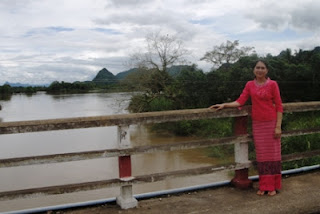We like to travel early.
So when the van carrying Sydney’s family arrived from Kali we departed. On the
outskirts of Kunhing we stopped to fill our car with gasoline and were
frustrated to see that the pump does not work automatically but found it to be
manual. It took about 30 minutes to have the tank filled and we can take off.
Let me relate a little
about the electricity they are using in Kunhing. The electricity they are
using here does not come from the hydropower station og
Kyaing-taung, which is only 50 miles away,
but is supplied by a small hydro plant owned by a native of Kunhing
called U Sai Nyo. The power supply is not adequate for the use of the town.
Most houses use power only for lighting and for mortars to draw water from
wells only . So big power consuming household appliances like washing machines
and micro-oven cannot be used even if the townsfolk can buy them. The
distribution of power is cut about 5 hours in the daytime and 5 hours during
the night. During summer the power supply is even more limited. So this may be
the cause that the petrol pump is only manual.
Our journey back to
Taunggyi was uneventful. The weather was fine. Only sometimes the rain fell but
mostly it was sunny. As I have written , many years ago when I was living in
Kunhing travelling along this road was an adventurous one . The people of
Kunhing can still remember unhappy events that had taken place on this
road. This bend, a few miles from Laikam
is the place where Saw Michael a Karen police officer was shot dead by insurgents. It was at this place that an army
squadron was ambushed and many fell.U STM would pointed out to us the places
where robbers usually came out. And when we came to Tahsai bridge which is on
the Nam Mong stream I remembered the incident when the car plunged into the
stream while trying to make a U turn.
Nang On our niece and also our host in Kunhing and some other passengers were
thrown into the water. Nang On had her throat
caught in a tangle of vine and she would be dead had someone not come to
her rescue. I remembered her eyes were blood red when she arrived back in
Kunhing. Some 3 or 4 people died in that accident.
I had been relating
unhappy episodes of the past. But there were also happy memories to be recalled
even if we may not be the persons to experience them. I remembered my mother telling me about their travelling
on this road. It may be round about 1930 when my mother was about 15. My mother
travelled to Taunggyi with my grandmother
in a single bullock cart with the cart driver as their only companion. As was
the custom of those days she was wearing heavy jewelleries but there were no
dangers of robbers or dacoits. It took them 2 weeks to arrive in Taunggyi. At
nights the driver slept on the ground and they slept in the cart she had said.
And in “ Lords of the
Sunset “ the author Morris Collis related about his travels in the Shan State.
He arrived in Kunhing from Merng Nawng and stayed at my grandmother’s house which
was on the east bank of the Nampang stream. The next day he said he reached
Kengtung which was 140 miles away. I wonder if such thing is possible in those days as I myself had travelled to Kengtung
round about 1970 in a convoy and had seen how terrible the state of the road
was. The road from Kunhing to Kengtung pass over hills and mountains and most
parts are tricky and dangerous that many accidents happen on that road.
Well…. I have written much
about the road, about the good and bad part of it . But whatsoever the state of
the road is people who live in the respective places have to use them. But we
cannot help grumbling and comparing it to better roads while travelling in a
car. We would compare it to the Japanese bullet train which will take over a
little than an hour for this distance.
and also to the Yangon Mandalay expressway where cars can be driven at over 100
KL an hour. I think I cannot expect to travel on such good roads during this
life. But maybe in the next life if I were to be born again in this area.
************************





















.JPG)

















